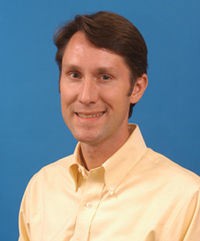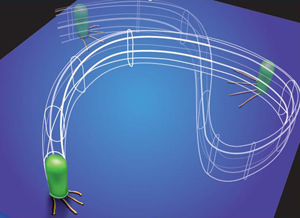
Talk about a walk on the wild side: University of Notre Dame researcher Joshua Shrout is co-author of a new paper that shows that bacteria are capable of “standing up” and moving while vertical.
Shrout, assistant professor of civil engineering and geological sciences and a member of Notre Dame’s Eck Institute for Global Health, has been studying the surface motility of bacteria since 2004. In 2008, UCLA researcher Gerard Wong suggested that an undergraduate bioengineering senior design group that he was advising track the bacterium Shrout was studying. After some interesting patterns were observed initially, Shrout collected more data to send to Wong’s group and they refined their analysis to allow for identification of very specific patterns by the bacteria, including “walking.”
In a paper appearing in today’s edition of the journal Science, Shrout, Wong and other researchers report on their findings.

“The significance of the work is that we show bacteria are capable of ‘standing up’ and moving while vertical,” Shrout said. “The analysis methodology developed by Gerard’s group made this observation possible. They developed a computer program to analyze time-lapse data series, just like those showing plant development that you watched on PBS as a kid, of bacterial motion on surfaces. By tracking thousands of bacteria for minutes to hours, the stand-up walking pattern was observed and verified to occur with some frequency.”
Apart from being an extraordinary insight into the behavior of bacteria, the findings have important biomedical implications.
“The significance to medicine is that the bacterium we study, Pseudomonas aeruginosa, causes lung, skin, eye and gastrointestinal infections,” Shrout said. “Such infections are, unfortunately, the leading cause of death for individuals with cystic fibrosis. As we learn more about how Pseudomonas aeruginosa colonizes surfaces, perhaps we can develop better methods to treat these infections.”
Dominick Motto, who was graduated from Notre Dame in May with a degree in biology, worked with Shrout on the on the experiments used in the research analysis.
“It has been great to work with Gerard’s group on this project because we have meshed multiple scientific approaches for this discovery,” Shrout said. “It also has been rewarding to integrate each level of researcher into this project: undergrad, graduate student, post-doc and professor. The ability to conduct cutting edge science while training future scientists is very rewarding.”
Contact: Joshua Shrout, 574-631-1726, Joshua.shrout@nd.edu